Playing with knives isn’t something to recommend to, well anyone really. But idle hands will find their way to a blade at some point, so curiosities may as well be channelled into something positive – like whittling! With a little guidance the ancient art of carving wood with a knife doesn’t need to turn into a first aid emergency. In fact, it can be a highly relaxing and therapeutic pastime – perfect for the creative camper to while away the hours in deep contemplation of the serenity that surrounds them. The ultimate getaway from the modern world.
But it’s not just campers who enjoy the remedies of whittling wood. If you are an aspiring carpenter and don’t have the luxury of a shed dedicated to your craft, a knife and chunk of whittle wood might just be the next best thing.
Whittling for beginners
I was given a whittling knife a few years ago by my sister, as a gift for being her bridesmaid. (She knows me well!) It comes with me on every camping trip and I love trying to work with the different wood types that might be lying around. I certainly don’t claim to be a ‘whittler’ and I’ve yet to create anything worth mentioning, (mostly spears to catch the cowboys with and the odd spoon here and there!) but I really enjoy having the tools to be creative in the outdoors when I have a bit of time on my hands.
Fancy trying your hand at this traditional craft? You’ll find all you need to know to get started in our beginner’s guide to whittling. Here’s what you’ll learn about:
- Pocket knives
- Whittling knives for beginners
- Sharpening your knife
- The best wood for whittling
- Protective gear for whittling
- How to whittle
- Whittling books
- Cool things to whittle
Whittling with pocket knives
Before I got my whittling knife I used my pocket knife, which, so long as it was sharp, did a great job. Throughout whittling history, whittlers used pockets knifes and some still choose them over specialised whittling knives. For me, the main benefit is that they are so portable. I always have my pocket knife on me during outdoor trips, so it’s nice to know that if the opportunity or need arises for some impromptu creativity, I’m covered. I also like that you can switch between the different blade sizes, depending on your need.
Using your pocket knife is a great way to try out whittling without investing in a ‘proper’ whittling knife. If you’re just beginning whittling then having a blade that has the ability to lock is something to consider. A non-locking blade can be unstable and tricky to work with, and the potential for lost fingers is also higher than with a locking knife.
If you’re in the market for a pocket knife anyway, then these Victorinox pocket knives will also suit your whittling needs:

Sentinel Swiss Army Knife
A super simple pocket knife, the Sentinel offers a slim and lightweight design with one lockable blade.
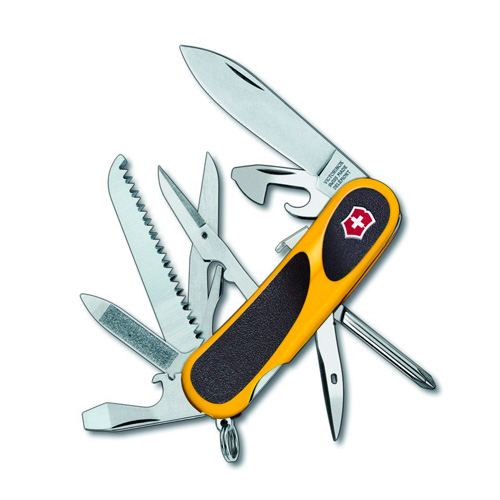
EvoGrip S18 Swiss Army Knife
A great multi-tool with an ergonomic handle for good grip. The EvoGrip has 11 implements with 15 different functions and a locking blade.
The best whittling knives for beginners
Knives that are designed specifically for whittling tend to be non-folding knives, so are a little less convenient for on the go wood carving. However, their fixed blade makes them more sturdy and their handles sit much more comfortably in the hand than pocket knives. That said, there are also some really excellent folding knives that are ideal for whittling, and some pocket knives that are specifically designed as whittling knives.
There are a ton of specialist whittling knife options out there and many whittlers have multiple knives for different jobs. Here are some of the best whittling knives out there, that are also ideal for beginner whittlers.
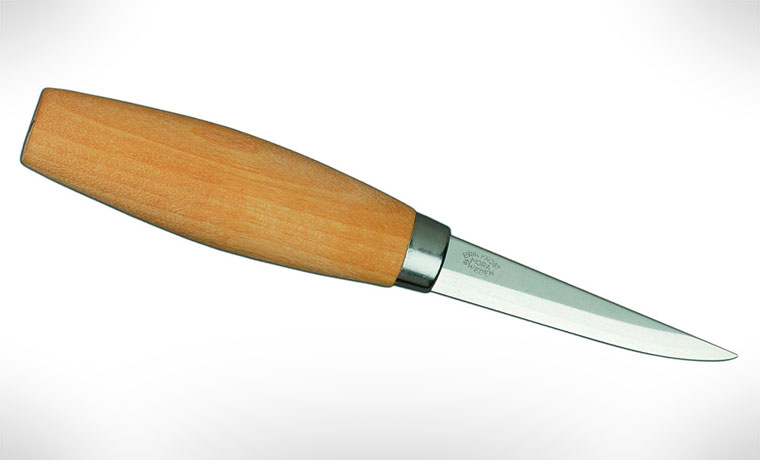
Morakniv 106
This all-purpose whittling knife is a really excellent choice as a first whittling knife that you won’t need to upgrade, perhaps ever! It has a limited lifetime warranty and the durable laminated steel blade will see you through many many happy years of whittling.
Although the Mora 106 will tackle most projects with no problem, the 3.2 inch blade makes this whittling knife one of the longer knives around and less well suited to intricate and detailed projects. And as your whittling projects get more ambitious, you may want to add the shorter (2.4 inch blade) Mora 120 to your tool kit.
Some whittlers prefer a more ergonomic handle like the Opinel, but the oiled Birchwood handle of Mora knives feels wonderfully at home in your palm. The finish is smooth but provides plenty of grip and control when tackling big rough cuts as well as more detailed work.
Find the latest price on:
Amazon
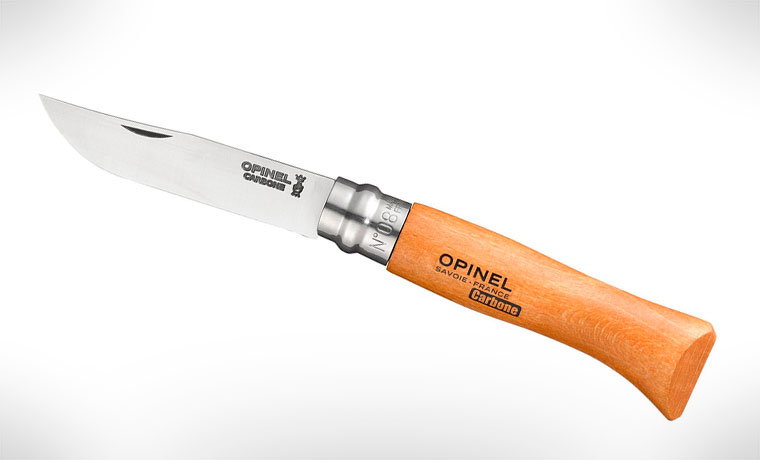
Opinel Carbon Blade No8
The Opinel No8 is one outstandingly great value knife. It is not designed as a specialist whittling knife, but its properties are such that its wood carving performance is comparable to other whittling specific knives like the Mora 106. The 3.25 inch carbon steel blade is, like the Mora 106, a little on the long side for intricate projects. But it is highly durable with excellent cutting quality.
What makes this whittling knife an appealing option for beginner whittlers is its versatility. The foldable blade makes it is more portable than the Mora whittling knives, and therefore immediately allows you to use it in a variety of camping and hunting scenarios. When the blade is open it locks very securely with a Virobloc safety ring. This also locks the blade when it is closed to prevent it from coming open in your pocket. The ergonomic Beechwood handle is also very comfortable to use, even for those with big hands!
Find the latest price on:
REI | Amazon
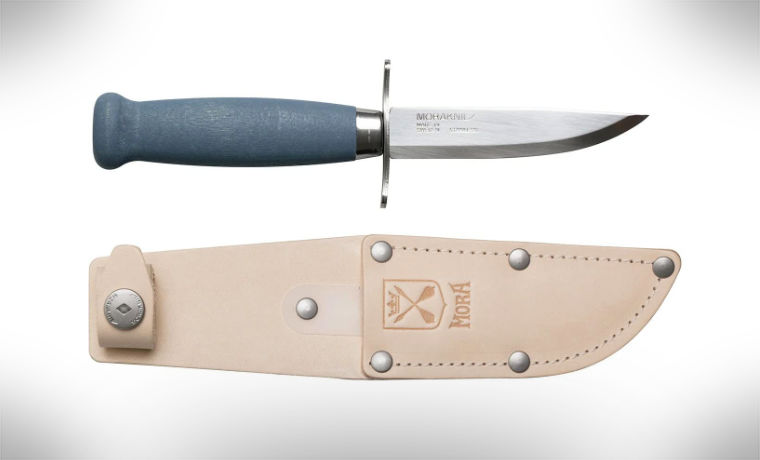
Morakniv Scout 39 Children’s Knife
If you’re keen to get your little ‘uns whittling away with you, then the Morakniv Scout 39 Children’s Knife is an ideal first knife. With a 3.4 inch blade and a small barrel-shaped stained or oiled Scandinavian birch oiled birch wood handle, the knife is a compact option for little hands. But what makes the Scout such a good option for young whittlers or those less confident handling sharp things, is the double finger protection guard at the base of the blade.
The Scout is by no means a lesser knife than its more mature cousins and shouldn’t be handled with any less caution; this is a very sharp knife that cuts through wood with the same strength and precision as any of the other whittling knives out there. And it goes without saying that budding whittlers will still need supervision when using this knife.
Find the latest price on:
Amazon
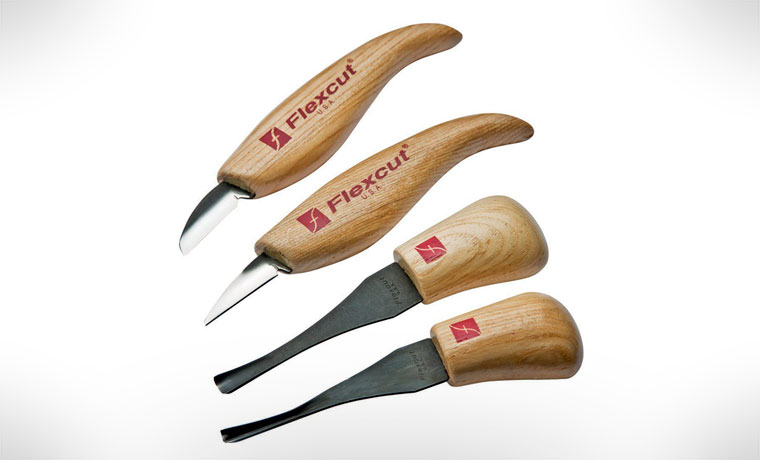
Beginner Palm and Knife Set
For newbie whittlers looking to leap right into the world of wood carving mania, this Flexcut Beginner Palm and Knife Set is THE place to start. Although it may be a little more pricey than other starter sets on the market, it is well worth paying the extra for the high quality hard carbon steel blades that won’t pack up on you after a year of use. The set includes:
- 1 all-purpose cutting knife
- 1 detail knife for close work
- 1 sweep knife (palm tool) for small projects
- 1 V tool (palm tool) for small projects
Made in the USA, the set comes with a tool roll to store the knives in when not in use, and are razor-sharp and ready to use right out of the package. And as some of the most popular whittling knives offered by Flexcut, this beginner set will last you well into your whittling career making it suitable for more advanced whittlers too.
Find the latest price on:
Amazon
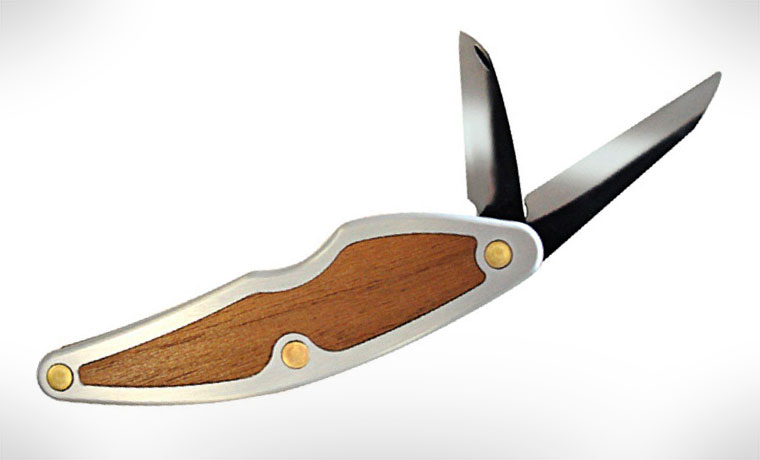
Flexcut Whittlin’ Jack
Another excellent knife from Flexcut, the Whittlin’ Jack combines the precise cutting quality of a fixed single blade whittling knife with the convenience and versatility of a pocket knife. AND they’ve added in a second blade into the bargain making this a superb option for whittling on the go. The high carbon steel blades are both on the short side compared with the Opinel: the detail knife is 1.5 inches long, and the roughing knife only slightly longer at 2 inches. Flexcut have selected the two most useful blades from the larger, more complex Carvin’ Jack that features 6 blades.
Where the Whittlin’ Jack falls short compared with the Opinel is the lack of locking mechanism on the blades. For more experienced whittlers this is no problem at all, and the small blades on this knife are more suited to advanced whittling anyway. But beginner whittlers may want to steer clear of this range of knives as their first whittling knife.
Find the latest price on:
Amazon

Morakniv Garberg
This may not be a knife that is specific to whittling in the way that most of the above optiions are, but if you are after a really excellent and exceptionally strong knife for all your bushcraft needs then look no further. As a recent addition to the Morakniv arsenal, the Garberg is a highly desirable knife for those who need something for all their camp and bushcraft needs, including wood carving and whittling. The 4.3″ long blade makes it tricky for work on intricate whittling projects, but the strength of the 3.2mm thick full tang* blade makes it a dream to work with tough wood on bigger projects. It also boasts a comfortable, ergonomic grip constructed of shock-resistant material, and the spine of the blade has been ground for use with a fire-starter.
A super strong and versatile knife that is ideal for general bushcraft and burly whittling projects.
*Full tang: the full width of the blade runs through the entire length of the handle which wraps around it in two parts. This makes the knife much stronger than a ‘half tang’ knife whose blade narrows inside the handle.
Find the latest price on:
Amazon
Sharpening your knife
The most important thing to know about how to whittle is that it is is much easier if you have a very sharp knife. The sharper the better.
To make sure your knives are always in optimal condition, you’ll need to add a sharpening stone to your wood whittling kit. Now there are many, many different techniques to sharpening your knife that use different types of stones and materials. But I like the simplicity of this method which uses minimal tools and seems to work well for my knives:
For this knife sharpening method you will need:
-
A two-sided sharpening stone
- An assortment of fine pieces of sandpaper
- A scrap of leather

The best wood for whittling
In the past I would pick up whatever wood was lying around the forest to get my campsite whittling projects going. But I was often choosing hardwood that became very tricky to work with as a beginner whittler, and usually, I just gave up. So as tempting as it may be to just grab whatever’s there, I would recommend being a little more selective about your whittling wood.
Try to avoid wood with knots and growth rings and, where possible, avoid wood where the grain goes in multiple directions – a straight grain is easier. Examples of softwoods to look for in the forest are Fir, Pine, Cedar, Larch and Spruce.
But if you are getting serious about your whittling then you can buy small whittling wood blocks at your local craft or hardware store which will be perfect for your first whittling project. Look for:
- Basswood
- Pine
- Balsa
Protective gear for beginner whittling
Now, because it’s essential that your knife is VERY sharp, it’s a good idea to have some protective gear. Keeping hold of all your fingers should be your first priority against the power of the blade. But I have also heard horror stories of gashed thighs from slip ups with sharp whittling tools. Who knew it could be such a risky pastime?! So if you’re worried about severing an artery in your leg then place something like a thick piece of leather or a wooden board on your lap. And to protect your fingers from losing their tips you might want to consider these options:
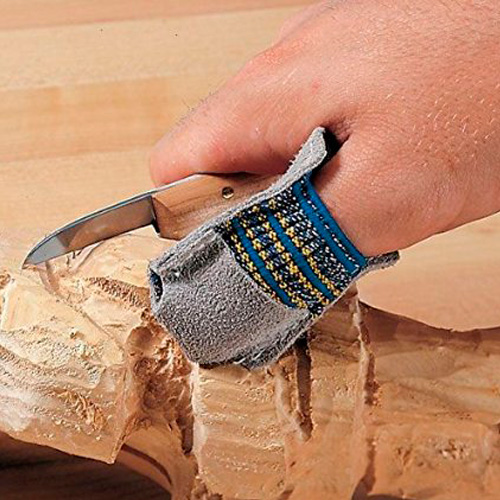
Carving thumb guard
It’s a good idea to wear a thumb guard when you are using the pull stroke to add detail to your project.
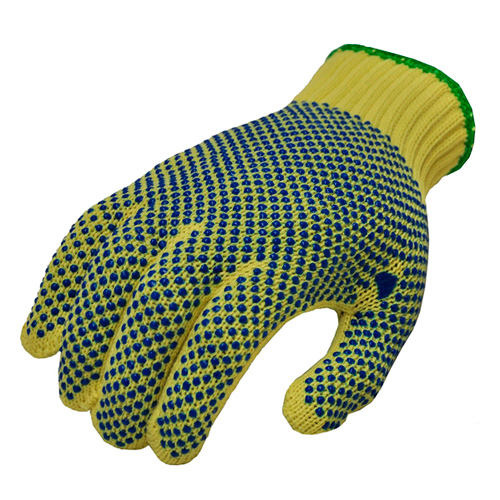
Cut resistant kevlar gloves
Kevlar gloves can be better than leather gloves as they provide a great degree of dexterity.
A few more safety tips for beginner whittling
-
Go slow, never make a big cut of any kind, but work into the cut slowly and gradually.
- Keep your knife sharp. This may sound counterintuitive for the safety of your fingers, but blunt knives are much more likely to skip across the wood instead of into it, and even dull knives can cut human flesh.
- Never whittle over your lap. Instead, do the work to one side of you so that any wayward strokes are directed into thin air, instead of the main arteries in your legs.
- Never a leave a knife sitting around if there are kids or animals around.
- Create an imaginary “blood bubble” around you. This is an arm’s length away from you in every direction. If any person or animal comes into your blood bubble, put your knife down immediately and ask them to leave the space, or move yourself somewhere else.
- If your knife has a sheath, take care when removing it. Over time, the stitching on sheaths can weaken and if yours decides to split just when you’re pulling your knife out of it, it can result in a nasty cut across your palm.

How to whittle
Now that you’re set up with a VERY SHARP KNIFE, and some protective gear, it’s time to get making some easy wood carving projects. First up you’ll need to learn a few basic strokes.
Straightaway rough cutting
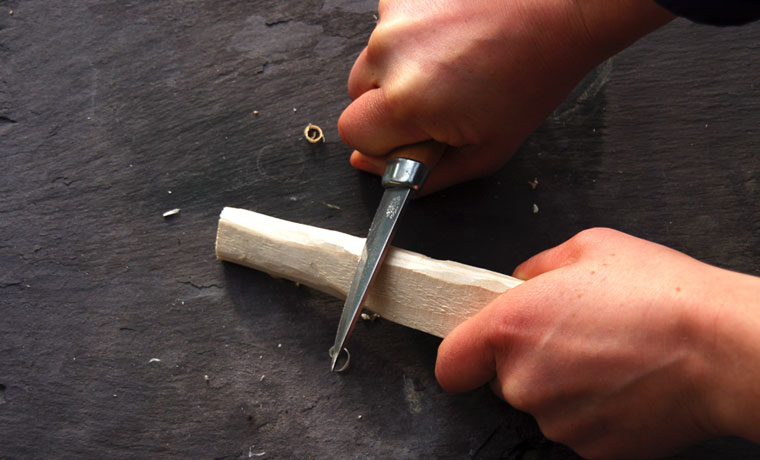
The push stroke (thumb push)
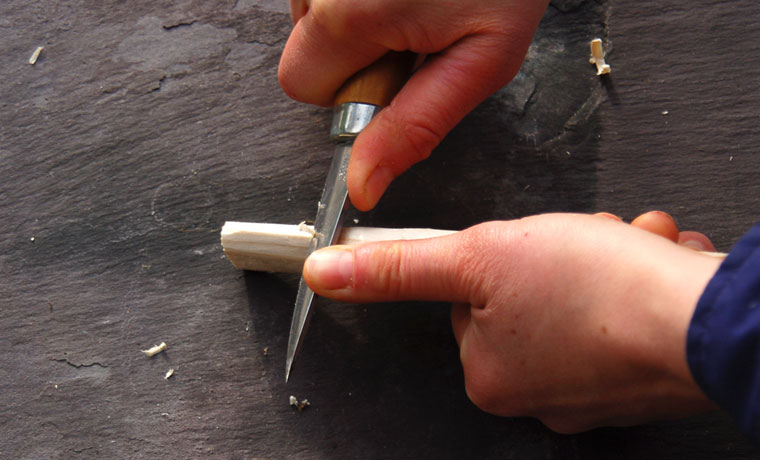
The pull stroke (paring cut)
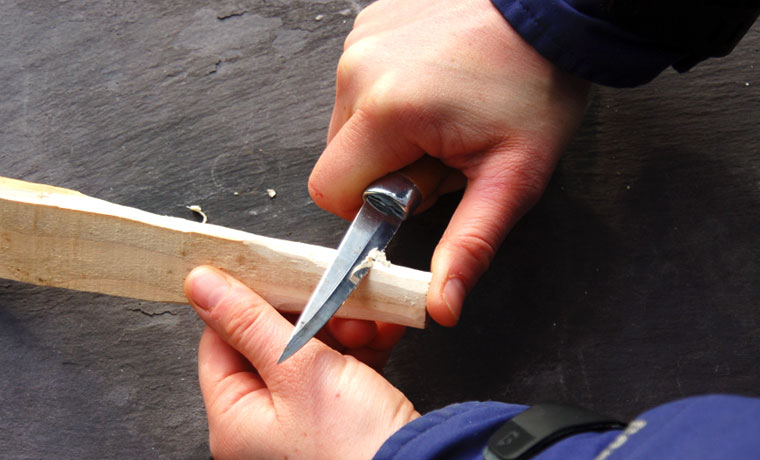
A good way to practice these strokes, or to introduce whittling to kids is to use a bar of soap.
Whittling books
There are some great whittling books available that go into much more depth to really get you set up, and also provide step by step guides for specific whittling projects and easy things to whittle. Here are a couple that I have enjoyed using:
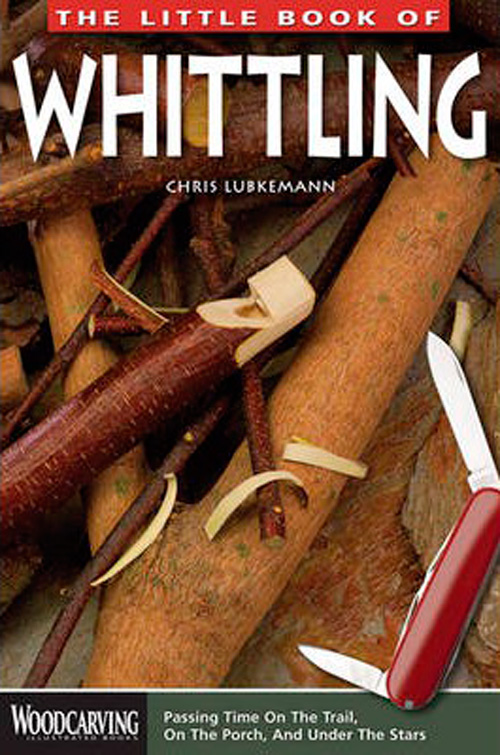
Little book of whittling
This is a great book to talk you through the basics. The whittling projects for beginners get progressively harder so try not to be tempted to move onto the next one before you’re ready.

Old Time Whittling
Old Time Whittling has some more tricky whittling projects but is still a good option for total beginners as it talks you through things very thoroughly.
Cool things to whittle
And finally, if you’re dying to get going and need some inspiration on some easy things to whittle, then you should learn:
How to whittle a knife
How to whittle a spoon
How to whittle a bear
Happy whittling, happy campers!
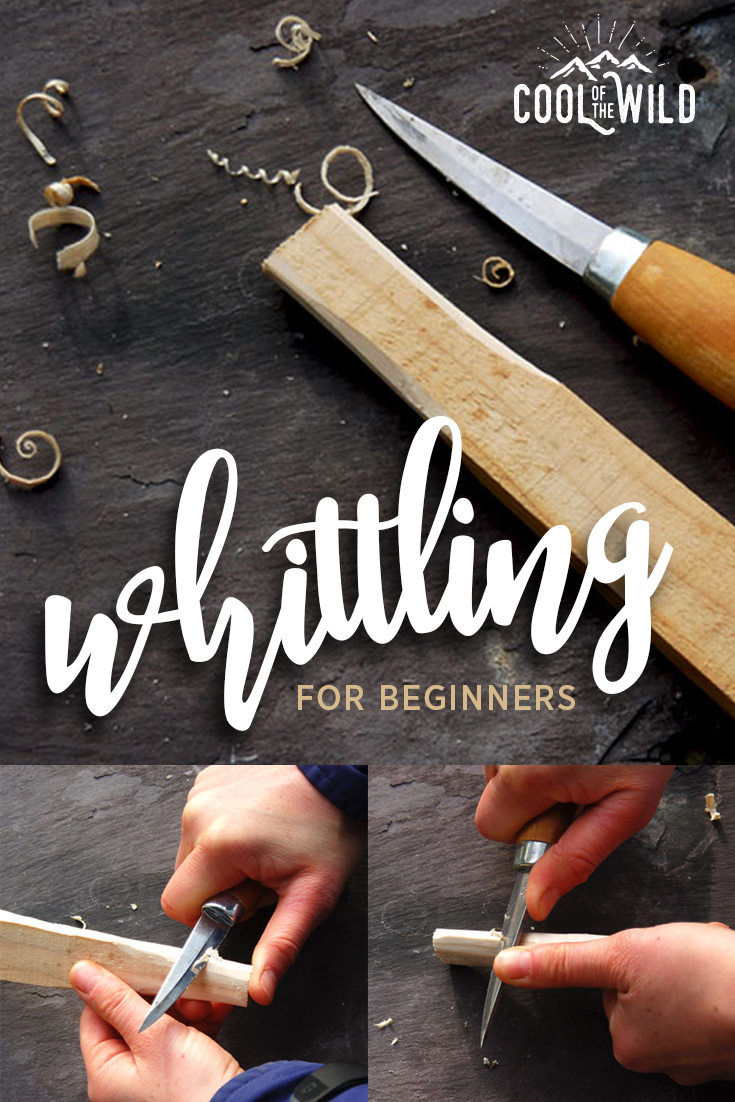
The post Whittling for Beginners: A Guide to the Basics appeared first on Cool of the Wild.


